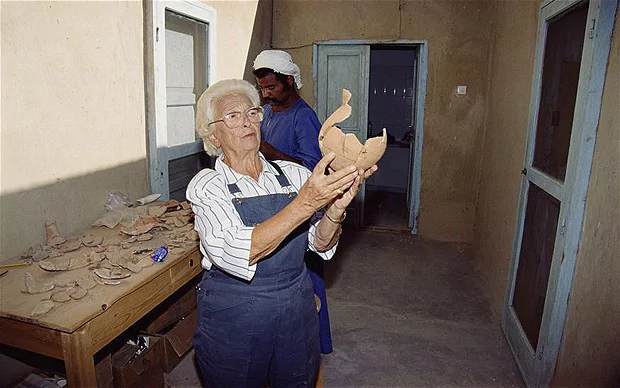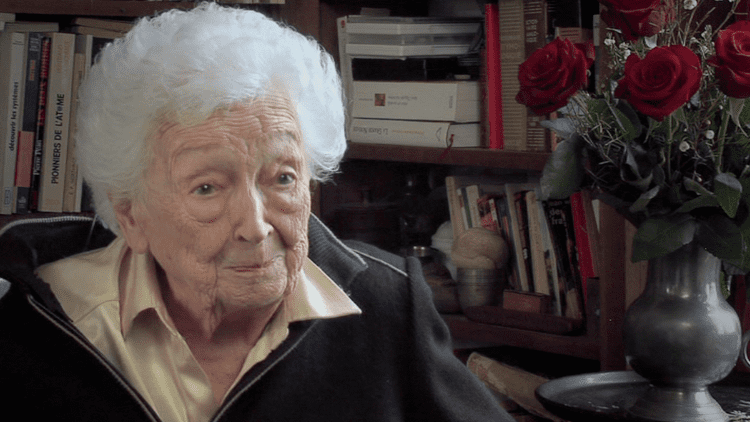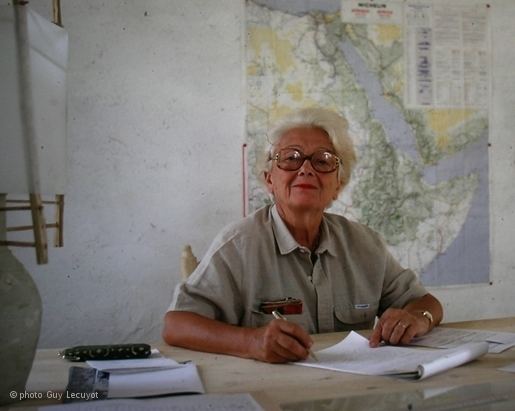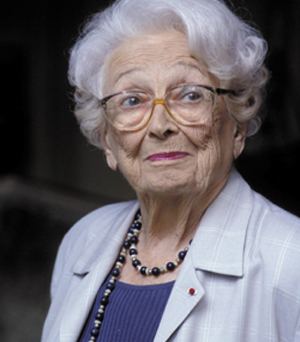Name Christiane Noblecourt | Role Author | |
 | ||
Died June 23, 2011, Epernay, France Books La femme au temps des pharaons, La reine mystérieuse Children Alain Desroches Noblecourt | ||
Christiane Desroches Noblecourt ([kʁistjan dɛsʁɔʃ nɔbləkuʁ]; 17 November 1913 – 23 June 2011) was a French Egyptologist. She was the author of many books on Egyptian art and history and was also known for her role in the preservation of the Nubian temples from flooding caused by the Aswan Dam.
Contents
- LEgyptologue Christiane Desroches Noblecourt et son quipe
- Background
- Aswan Dam project
- UNESCOs Campaign to Save the Temples
- Aftermath
- Awards
- Publications
- References

L'Egyptologue Christiane Desroches Noblecourt et son équipe
Background

She was born Christiane Desroches on 17 November 1913, in Paris. In 1922 she was fascinated by Howard Carter’s discovery of the tomb of Tutankhamon, and encouraged by Father Étienne Drioton, she joined the Egyptian Antiquities department at the Louvre. She was the first woman to be a fellow of the French Institute of Oriental Archaeology (IFAO), and was also the first woman to lead an archaeological dig, in 1938.

During World War II she joined the Resistance, and hid the Louvre’s Egyptian treasures in free areas of France.

She died on 23 June 2011 at 97.
Aswan Dam project

The construction of the new Aswan High Dam led to Noblecourt’s greatest accomplishment: the preservation of ancient Nubian temples from flooding caused by the dam. The first dam, completed in 1902 with a capacity of a billion cubic meters, had been deemed insufficient and raised in 1912, and again in 1934. The dam’s capacity still could not meet the needs of Egypt’s ever-growing population, and in 1954 the government of Gamal Abdel Nasser decided to build a new dam with a capacity of 157 billion cubic meters, 500 kilometers long, which would extend into Sudan. It has been described as a project worthy of the pharaohs.
The monuments of ancient Nubia would have been flooded and lost forever if the project had gone ahead as planned, among them the temples of Abu Simbel. In the words of writer Pierre Loti, who visited the area shortly after the first dam was completed:
“The greater part of the ancient temples of Nubia will be underwater. . .but the cotton fields will be so productive!”
It is alleged that UNESCO immediately asked Noblecourt, who was then curator of Egyptian antiquities at the Louvre, to create an inventory of all the threatened historical sites. It then undertook the colossal task of finding the funding necessary to save them.
However, there is no evidence to back this allegation, especially that most European archaeological excavations to Egypt were halted after the 1956 Suez Canal war. The following account of UNESCO's involvement in the campaign to save the monuments and temples of Nubia can be confirmed from several documents.
UNESCO's Campaign to ٍSave the Temples
On 23 January 1959 Mr. René Maheu (1905-1975), Deputy Director General for UNESCO addressed the Egyptian Minister of Culture, Dr. Tharwat Okasha with a formal letter in which he asked Dr. Okasha to formally submit a request to UNESCO for its aid in supporting the project regarding the saving of the monuments of Nubia, an idea presented to Mr. Maheu during his visit to Cairo. (ref: Tharwat Okasha, "Insan al`asr Yutawwig Ramsis" (Modern Man Coronates Ramsis), Egyptian High Council for Antiquities, Cairo 2008, p. 281). That was the first time that UNESCO had heard of the campaign for rescuing the monuments of Nubia, an idea clearly the brain child of Dr. Tharwat Okasha and approved by his consultants in the Center for Monuments Recording in Egypt, and first discussed with Maheu during his visit to Egypt before January 1959.
On April 6, 1959, the Egyptian Minister of Culture, Dr. Tharwat Okasha, sent a letter addressed to the Director General of UNESCO, Vittorino Veronese (1910-1986),in which he requested the approval of UNESCO to act as an "intermediary" to ensure obtaining "wide range international financial and artistic aid to protect the priceless artistic and historical treasures that are in threat of being forever lost after the construction of the High Dam project in Aswan." The document continued to outline the work that was to be supported by this aid (studies of the area, recording of monuments, new excavations, plus relocation of existing monuments away from the rising water to higher safer locations). The document also clearly stated the commitments of the Egyptian Government towards those efforts, which can be summarized as: partial financial contribution plus allowing all archaeological entities participating in the project to keep 50% of any new finds discovered during excavations.This letter is considered to be the seed from which the project for saving the Monuments of Nubia Project started.(Okasha 2008, pp. 56, 282-283).
Dr. Okasha was invited to present the case in front of the 54th meeting of the Executive Comity of UNESCO in June 1959, which he did over a two-hour presentation after which the members expressed their support for the project with a "several minutes standing ovation" after the presentation (Okasha, 2008, pp. 56–57.) with the 24 members giving their consent to the Director General of UNESCO.
An international conference for the preliminary studies was held in Egypt in October 1959 in which the commitments of the Egyptian Government were confirmed with the release of a formal Egyptian Governmental decree outlining the benefits given to all archaeological entities that will respond to the upcoming call of UNESCO for participation in the saving of the monuments of Nubia (Okasha,2008, pp. 284–285).
On March 8, 1960, the Director General of UNESCO, Mr. Vittorino Veronese,issued his international appeal to the world for participation in the project for saving the Nubian Monuments in Egypt.
There is no mention or any evidence in any of the official correspondence or documents that Noblecourt was a key player in those activities nor was she mentioned in the official call by UNESCO. It was only through the work of Tharwat Okasha and the response of René Maheu then Vittorino Veronese that the credit for starting this project should be given. Okasha vehemently denied the role claimed to have been played by Noblecourt and calls all such claims "cultural theft of Egyptian efforts" (Okasha 2008, pp. 184–194). He has also presented documents that refute any alleged meetings by Noblecourt with President Gamal Abdelnassir.(Okasha 2008,p. 305). He has also expressed his disdain and surprise of such claims in numerous personal conversations and in the Cairo press.(http://www.ahram.org.eg/Archive/2007/11/24/Writ2.htm accessed 23/10/2015)
Not only would more than fourteen temples have to be moved, but urgent excavations would need to take place at sites that would soon be under several dozen meters of water.
André Malraux, then the French Minister of Cultural Affairs, added his voice to the appeal:
“The power that created the colossal monuments threatened today. . . speaks to us in a voice as exalted as that of the architects of Chartres, as that of Rembrandt. . .Your appeal is historic, not because it proposes to save the temples of Nubia, but because through it the first global civilization publicly claims the world’s art as its indivisible heritage. . .There is only one action over which the indifference of stars and the eternal murmuring of rivers have no sway - it is the act by which man snatches something from death.”
Fifty countries, in the middle of the Cold War, contributed funds to save the monuments now considered part of the heritage of all humanity. Philae, Kalabsha, Wadi al-Sabua, Dakka, Derr and other sites were moved, with the temples of Abu Simbel receiving the most media attention. The temple of Amada was a difficult case, because of its small, beautifully painted reliefs. Chopping it into blocks, as was being done with the other temples, was not an option; the paintings would not have survived. Seeing that all seemed resigned to see the temple flooded by the silty waters of Lake Nasser, Christiane Desroches Noblecourt announced that France would save it. She asked two architects to propose a method for moving the temple in one piece. Their idea was to put the temple on rails and transport it hydraulically to a site a few kilometers away that was more than 60 meters higher. (needs citation).
More funds were needed for this ambitious project. To this end Christiane Desroches Noblecourt requested an interview with Charles de Gaulle, who had no idea of the commitment she had made in the name of her country. Reportedly on learning of it, he demanded, “Madame, how dare you say that France will save the temple, without authorization from my government?” Noblecourt replied, “General, how dare you make an appeal on the radio without authorization from Pétain?” De Gaulle agreed to honour Noblecourt's promise. (needs citation).
Ultimately the rescue project, including the transportation and reconstruction of the temples on their new sites, took twenty years.
Aftermath
The preservation of the Nubian monuments was to have unexpected consequences. The first was an improvement in Franco-Egyptian relations, which had been poor since the Suez Canal crisis of 1956. This in turn led to the organization of a Tutankhamon exhibition at the Louvre in 1967, which attracted a record number of visitors, followed by the exhibitions of Ramses II in 1976, and Amenophis III in 1993. In recognition of France’s contributions to the preservation of the Nubian temples, the government of Anwar Sadat donated to the Louvre the bust of Amenhotep IV, better known as Akhenaton.
Awards
In 1975 Christiane Desroches Noblecourt received the prestigious gold medal of the French National Center for Scientific Research (CNRS). In January 2008, she was awarded the Grand Cross of the Légion d'honneur, the highest decoration in France.
